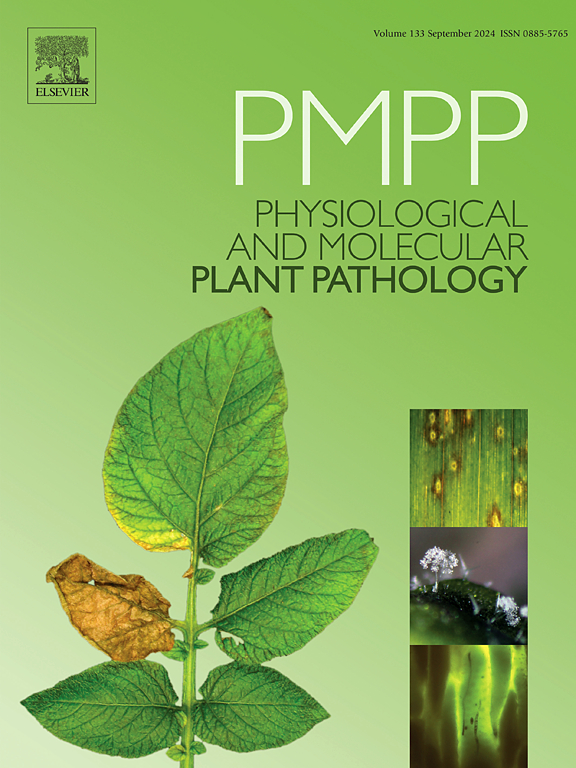Simultaneous detection of multiple begomoviruses in individual whitefly (Bemisia tabaci) using multiplex PCR and identification of whitefly cryptic species
IF 2.8
3区 农林科学
Q2 PLANT SCIENCES
引用次数: 0
Abstract
Bemisia tabaci, the whitefly (Gennadius) (Hemiptera: Aleyrodidae), a major pest of vegetable crops, has emerged as a significant constraint in Indian agriculture. In August 2023, B. tabaci samples were collected from the chilli fields in the Trichy and Perambalur districts of Tamil Nadu. Genomic DNA was extracted from individual whiteflies using a modified conventional extraction method. The primary objective of this study was to detect multiple begomoviruses in the individual whitefly vector using Multiplex PCR (M-PCR), and to identify the cryptic whitefly species present in the study area. To achieve this, the study focused on the modification of DNA isolation protocol and the M-PCR assay for efficient virus detection in individual whiteflies. The M-PCR assay successfully detected three distinct chilli leaf curl viruses in the whitefly DNA namely Begomovirus capsibhavanisagarense [chilli leaf curl Bhavanisagar virus (ChiLCBV)], chilli leaf curl Salem virus (ChiLCSV), and Begomovirus capsisrilankaense [chilli leaf curl Sri Lanka virus (ChiLCSLV)]. To investigate the relationship between whitefly cryptic species and the number of viruses detected, the mitochondrial cytochrome c oxidase subunit 1 (mtCOI) gene was amplified using species-specific primers. PCR amplification yielded the expected 800 bp mtCOI gene fragment, which was subsequently subjected to Sanger sequencing. The results confirmed the presence of the Asia II 5 cryptic species in the sampled populations. These findings highlight the role of Asia II 5 in the transmission of begomoviruses and emphasize its relevance in developing targeted whitefly and virus management strategies.
多重PCR同时检测白蝇个体(烟粉虱)多种begomovirus及白蝇隐种鉴定
烟粉虱(半翅目:烟粉虱科)是蔬菜作物的主要害虫,已成为印度农业的重大制约因素。2023年8月,在泰米尔纳德邦特里希和Perambalur地区的辣椒地里采集了烟粉虱样本。采用改进的常规提取方法提取白蝇个体的基因组DNA。本研究的主要目的是利用多重PCR (M-PCR)检测单个白蝇载体中的多种begomovirus,并鉴定研究区存在的隐型白蝇种。为了实现这一目标,研究重点是修改DNA分离方案和M-PCR检测方法,以便在白蛉个体中有效检测病毒。M-PCR方法成功地在粉虱DNA中检测到三种不同的辣椒卷叶病毒,分别是begomvirus capsibhavanisagarense[辣椒卷叶病毒(ChiLCBV)]、辣椒卷叶病毒Salem (ChiLCSV)和begomvirus capsisrilankaense[辣椒卷叶斯里兰卡病毒(ChiLCSLV)]。为了研究白蝇隐种与检测到的病毒数量之间的关系,利用种特异性引物扩增了白蝇线粒体细胞色素c氧化酶亚基1 (mtCOI)基因。PCR扩增得到预期的800 bp mtCOI基因片段,随后进行Sanger测序。结果证实了亚洲II - 5隐种在样本种群中的存在。这些发现突出了亚洲II - 5在贝古莫病毒传播中的作用,并强调了它与制定针对性的白蝇和病毒管理策略的相关性。
本文章由计算机程序翻译,如有差异,请以英文原文为准。
求助全文
约1分钟内获得全文
求助全文
来源期刊
CiteScore
4.30
自引率
7.40%
发文量
130
审稿时长
38 days
期刊介绍:
Physiological and Molecular Plant Pathology provides an International forum for original research papers, reviews, and commentaries on all aspects of the molecular biology, biochemistry, physiology, histology and cytology, genetics and evolution of plant-microbe interactions.
Papers on all kinds of infective pathogen, including viruses, prokaryotes, fungi, and nematodes, as well as mutualistic organisms such as Rhizobium and mycorrhyzal fungi, are acceptable as long as they have a bearing on the interaction between pathogen and plant.

 求助内容:
求助内容: 应助结果提醒方式:
应助结果提醒方式:


